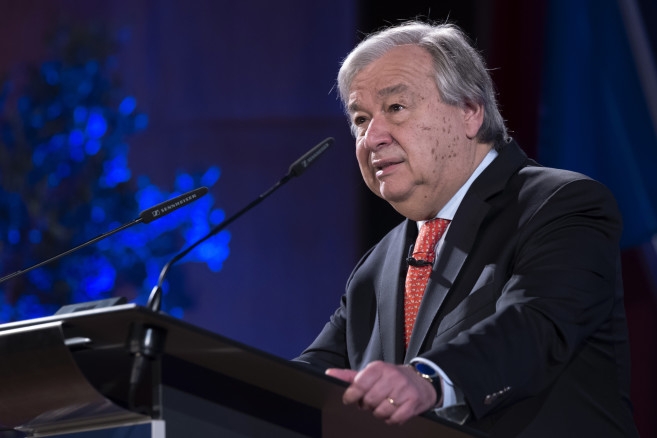In his speech and report to launch the new agenda for disarmament , “Securing our Common Future – An Agenda for Disarmament”, United Nations Secretary-General António Guterres outlines the humanitarian harm caused by the use of explosive weapons – particularly those with wide-area effects – in populated areas, and reiterates his support for the development of an international political declaration. As well as framing the problem, his report suggests a number of practical measures aimed at reducing harm to civilians and strongly encourages further work by states to develop an international political declaration to tackle this pressing humanitarian issue. Despite this and a call to “rein in the use of explosive weapons in populated areas”, the report unfortunately misses the opportunity to restate the call to action contained in Guterres’ recent protection of civilians report and that of successive UN Secretary-Generals, urging states to avoid the use of explosive weapons with wide-area effects in populated areas.

Secretary-General António Guterres presents his agenda for disarmament “Securing Our Common Future” at University Dufour in Geneva. UN Photo/Jean-Marc Ferré
“Civilians continue to bear the brunt of armed conflict across the globe”
The report highlights the severe impact use of explosive weapons in populated areas has on civilians, referencing AOAV’s data suggesting a 92% civilian casualty rate, identifying it as “a leading concern”, and emphasising both the immediate and long-term “patterns of harm” caused by such use. The Secretary General’s (UNSG) analysis on the impact of explosive weapons in populated areas largely falls under a section of the report focussing on “protection of civilians against the urbanisation of armed conflict”, a phenomenon the he describes as having “devastating and well-documented impacts on civilians”. Certain weapons systems, notably “…indirect fire weapons, such as artillery, rockets and mortars, weapons that fire in salvos, such as multi-launch rocket systems, large air-dropped bombs and surface-to-surface ballistic missiles”, are singled out as particularly problematic due to their wide-area effects.
These wide-area effects were referenced again by the UNSG in the context of disproportionate civilian harm, when he emphasised that, when used in populated areas, “explosive weapons with wide-area effects… can be expected to result in a high proportion of incidental civilian harm.” His report also resists the conflation of deliberate attacks on civilians with the humanitarian devastation wrought by the use of explosive weapons in populated areas, by specifically distinguishing between “deliberate attacks on the civilian population and civilian objects, indiscriminate attacks, the inappropriate selection of weapons and a failure by parties to conflict to take constant care to spare civilians and civilian objects from the impacts of warfare”.
Action to prevent harm from explosive weapons
Turning to action to prevent or mitigate the harms outlines, the UNSG’s report calls for “new efforts to rein in the use of explosive weapons in populated areas”, and sets out a number of practical action points including awareness-raising, casualty-recording, and the introduction of “civilian harm mitigation cells” in militaries. He also expresses his intention to continue supporting Member States’ efforts to “develop a political declaration, as well as appropriate limitations, common standards and operational policies in conformity with international humanitarian law relating to the use of explosive weapons in populated areas”.
Though his report raises salient concerns regarding the use of explosive weapons with wide-area in populated areas and identifies paths forward in mitigating their impact – repeating again his support for the development of a political declaration – his comments nevertheless fall short of directly calling for states to avoid their use. In this, he misses the opportunity to reiterate the calls of previous UNSGs, and indeed that of his own report on the protection of civilians in armed conflict released only ten days prior, for states to “avoid the use of explosive weapons with wide-area effects in populated areas”. In the same report, he also urged states to ensure that “specific steps [are] taken to mitigate civilian harm” when the use of these weapons is deemed unavoidable.
In its other prescriptions for progress on this issue, the new report does, however, reflect the emphasis in his recent protection of civilians report on strengthening data collection and developing national operational policies as a means to better understanding and reducing civilian harm from explosive weapons. He references the collection of data as “an important practical step…to effectively address concerns raised by the use of explosive weapons in populated areas”, focusing in particular on the importance of disaggregated data on the category of arms in contributing to the development of global, regional and national practice, policies and norms on protecting civilians, as well as to implementing arms embargoes and to informing risk assessments applicable to arms transfers. Citing the 2017 OCHA compilation of military policy and practice on explosive weapons in populated areas, and in particular the lessons from ISAF’s tactical directive and AMISOM’s indirect fire policy, he also emphasised the importance of sharing policies and practice aimed at “[strengthening] the protection of civilians by limiting the use of explosive weapons in certain circumstances”.
The newly-issued report rightly frames the use of explosive weapons with wide-area effects in populated areas as a pressing and multi-faceted humanitarian problem, and sets forth clear practical measures that states can take to improve civilian protection, as well as emphasises the SG’s enduring commitment to the development of a strong and comprehensive international political declaration.
